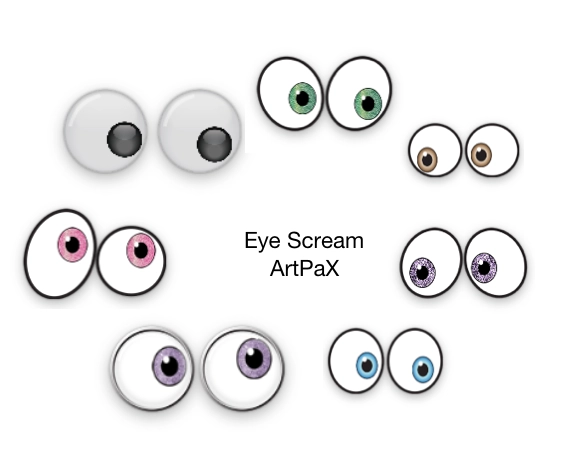EyeSpy (Version 2)
for macOS 10.12 (Sierra) and macOS 10.13 (High Sierra)
A Brief History of the Concept Behind EyeSpy
We stand on the shoulders of disembodied cartoon eye giants.
The concept of cartoon eyes following the mouse cursor (as in EyeSpy) comes with a rich history.

Ever since those early days of the first graphical computers every new platform has seen a toy with cartoon eyes watching the mouse cursor — at least on every computer platform with a mouse! This concept has a lasting popularity, we believe, for a fascinating reason. It turns out that humans are highly evolved to be able to effortlessly tell what somebody else in the vicinity is looking at. You'll notice this, now, everywhere you go. If you're in a coffee shop, your brain automatically knows who around you is looking at what things.
The idea may have been invented independently by at least two different people.
As a result, people are automatically attracted to this toy at a subconscious level. We were actually surprised by how many people in our marketing focus research responded positively to pre-release demonstrations of EyeSpy. When people see it, they get it.
This all-new version of EyeSpy is inspired by prior mouse-following toys.
(original name unknown)
Apparently created by Jeremy Huxtable for the NeWS windowing system and shown at SIGGRAPH '88, this is the first well-known version of the cartoon eyes concept.
A fun footnote to the history of the concept, William T. Roberts claims to have written a slightly earlier such app, for the NeWS platform, at Queen Mary College (University of London) in late 1986. He wrote on a Wikipedia discussion for NeWS:
"Mine was superior - it used a round canvas for the eye, a round child canvas for the pupil, and allowed the centre of the pupil to go as far at the edge of the eye, relying on NeWS to clip the result to give a proper cartoon eyeball effect. I also remember that it exposed what I felt was a bug, namely that the position of the child canvas was not specified relative to the origin of the parent canvas. I've got at least one colleague who remembers it and can place the date, but I'm unable to find any other hard evidence of it. I've also failed to contact Jeremy Huxtable, to find out if he remembers seeing my version, or if his idea arose spontaneously."
Many great ideas arise spontaneously when the time is right. The concept is becoming known as Multiple Discovery. Famously, both Calculus and the theory of Evolution—two of the most important discoveries in human history—were each developed independently at roughly the same time by two different people.
Created in the early 1990s for the X-Windows system by Keith Packard, for the MIT X Consortium, Xeyes is probably the best-known implementation. These early versions were simply a pair of cartoon eyes, with no adornment, circles to define the eyeball, and a smaller black circle to define the pupil.
Created by Slipped Disc Software in the mid 1990s for Mac OS 6.0 through 7.6, an app called Homer Pro developed a bit of a following.
Dedicated to Matt Groening and Dan Castellaneta of The Simpsons, Homer Pro didn't last very long because it wasn't a licensed work and used the copyrighted visage of Homer Simpson. If your cursor got too close to him, he ate it, and then belched!
Created for the X-Windows system by Ivo van der Wijk, tuXeyes may have introduced the use of cartoon characters around the eyes. Early characters were mostly mascots for operating systems like the LinuX cartoon penguin, Tux, for whom it’s named.
Created for the NeXTSTEP/OpenStep system, by Roger Rosner in 1989, a nostalgic implementation offering simple cartoon eyes, as purist nod to the original concept. At the time of this writing (February 2017) Roger’s Eyecon.app was still available for download, in case you happen to have a NeXT Cube or NeXTStation Color Turbo around, somewhere.
In the early days of macOS illumineX created an original ground-up implementation of the mouse tracking toy using Objective C. It offered a choice of cartoon characters, mostly operating systems mascots (very geeky!) Don Yacktman of MiscKit fame (it was the world's first free, open source object kit) was the lead developer on that version. He had also made an earlier version of EyeSpy for NeXTSTEP.
Today’s version of EyeSpy is a brand new implementation written in Apple's Swift programming language by Alex Cone and Arlan Titchbourne.